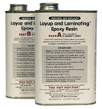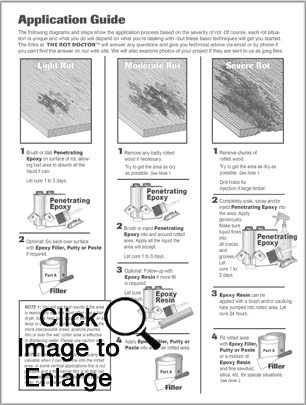Home > Product Line & Price List > Layup & Laminating™ Epoxy Resin

Layup & Laminating™
Epoxy Resin
- An Overview
- Advantages
- Mixing & Application Techniques
- Some Useful Information from
The Rot Doctor

An Overview
Layup and Laminating™ Epoxy Resin was originally designed for ease of use in resin/fiberglass/composite construction. It is exceptionally durable in wood/fiberglass/epoxy composites. It was formulated to have a relatively low viscosity and special wetting agents to rapidly wet out fiberglass cloth. When used to wet out fiberglass, you will need approximately one ounce of Layup and Laminating Epoxy Resin (by weight) for each ounce (per yard) of fiberglass cloth. For example, one yard of 6 ounce fiberglass cloth will require 6 ounces (by weight) of Layup and Laminating Epoxy Resin to wet out properly. A gallon of L&L Resin will wet out 10 square yards (8 sq. m.) of 6 ounce fiberglass cloth. We have found it to be an ideal follow-up resin for wood repair, either as a brush on or poured/pumped into cavities previously saturated with Clear Penetrating Epoxy Sealer™.
Packaging
L&L Resin is available in 12 oz, 2 Pint, 2 Quart, and 2 Gallon units.
Characteristics and Advantages
-
A high grade epoxy resin that mixes 50:50 by volume. The mixing ratio is not critical; ±10% off volumes will not alter the cured properties significantly. When first mixed it is thick and “milky”, but thins in the pot and turns almost transparent when it is cured. Have resin at room temperature before mixing. At temperatures of 75°F (24°C) and below, we recommend that you give the resin about 15 minutes of “pot cure” time to thin-out before applying. At higher temperatures, use immediately.
-
At temperatures above 80°F (27°C) the set time for the resin will be significantly accelerated. For normal bonding/filling this is not a big issue. You simply mix less resin at one time. When using as a pour-fill into deteriorated wood, however, we recommend that application be delayed until temperatures are below 80°F (27°C), or that the resin be cooled in the can (immerse closed cans in cold water or refrigerate) prior to mixing/applying.
-
Coverage is approximately 45 sq. ft. per gallon at 1/32″ (4.1 sq m. per 3.8 liters at 0.8 mm.) when used to laminate wood to wood, wood to fiberglass, or similar applications.
-
The low viscosity was achieved by chemical engineering. There are no plasticizer oils, extender oils, or non-reactant diluent oils that are commonly found in low viscosity systems and which can bleed or migrate with age to cause cracking and loss of adhesion.
-
The cured resin is not brittle. It is slightly flexible so that it can move with the natural flexure or elongation of wood or fiberglass. The relatively long cure time allows resin to penetrate to all vacant wood cavities.
-
Develops the least “blush” of any commercially available epoxy system.
-
Four-hour thin-film time at 75°F (24°C) allows solvent clean-up; no grinding of cured drips.
-
Full cure guaranteed to 28°F (-2°C). Shelf life in excess of 5 years. Component A is moisture sensitive and must be kept sealed. Do not allow to freeze.
Layup and Laminating Epoxy Resin can also be used as a general purpose adhesive. Normal coverage when using as an adhesive is approximately 45 sq. ft. per gallon at 1/32″ (4.1 sq. m. per 3.8 liters at 0.8 mm.). This is the minimum recommended amount to get a strong glue joint. Any less, and there is a risk of not having enough glue in the joint, commonly referred to as “starving the joint”. When bonding rough surfaces it is often necessary to use twice as much glue or more to avoid starving the joint. In these cases, coverage will be reduced by half or more. When clamping glue joints, be careful not to over-tighten the clamps.
Mixing & Application Techniques
For best mixing we recommend that Part A and Part B be throughly mixed in one container, and then put into a second container and mixed again with a new mixing stick or a clean paddle blade. This will ensure that no unmixed residue contaminates the final application mix.
While we primarily use L & L Resin to repair rotted wood, it is an excellent fiberglassing resin as well. L & L Resin will wet out fiberglass cloth at the rate of one ounce of resin (by weight) for every ounce (per yard) of fiberglass cloth. For example, one yard of one ounce fiberglass cloth would take one ounce (by weight) of epoxy resin to wet out properly. By volume, this equals approximately two ounces of L & L Resin per ounce (by weight) of fiberglass cloth. A gallon of L & L Resin will wet out 10 square yards (8 sq. m.) of 6 ounce fiberglass cloth.
NOTE: Bulk mixing (more than two quarts at one time) is not advised. It makes a thorough mix more difficult, and it concentrates more resin in one location which will generate induction heat and further accelerate the set time.
Mixed viscosity is 1000 centipoise at 72°F (22°C), comparable to other low viscosity epoxy systems. At 72°F (22°C) the pot life is 1 hour, the thin-film set time is 4 hours, and the time to fully cure will be about 1–2 days. At 55°F (13°C) full cure will be about 2–4 days.
NOTE: For application into tight areas, we prefer to use our Re-useable Poly Caulking Tubes. You fill the tube with L & L Resin, with or without a thickener, put the plunger in and load into a standard caulk gun. After cutting the tip to the size required, squeeze the L & L Resin into place. These empty 10 oz caulking tubes are for sale on our order form as part number 117. Customers have also reported good results with hand-crank transmission oil pumps purchased from your local automotive supplier. Designed to pump thick fluids, and cheap enough to be considered disposable, we feel that they would work fine.
Layup & Laminating Epoxy Resin is often used as a filler or a pourable slurry for voids in wood, fiberglass or concrete. Sawdust, milled/chopped fiberglass and fumed silica (Cab-O-Sil®) are all good general purpose products which can all be added to the resin as thickeners. The more you add the thicker the mix. When adding thickener, it’s important that the Layup & Laminating Epoxy Resin be thoroughly mixed BEFORE the thickener is added. The thickener is then added slowly while stirring the mixed resin until the desired consistency is reached.
ALWAYS MIX THOROUGHLY!
IMPROPER MIXING IS THE GREATEST CAUSE OF EPOXY SYSTEMS FAILURE.
Be sure to thoroughly scrape sides of mixing container to get all unblended resin.
If in doubt, transfer first mix into a second container and mix again.
Layup and Laminating Epoxy Resin is a hazardous product. Check the shipping options page for details on shipping hazardous items. For additional information, refer to the Layup and Laminating Epoxy Resin Safety Data Sheet.
PDF Documents
You will need a PDF reader to view these links, you can download Acrobat Reader for free from Adobe’s website.
Safety Data Sheets: Part A & Part B (both parts are needed, they are separate sheets)
